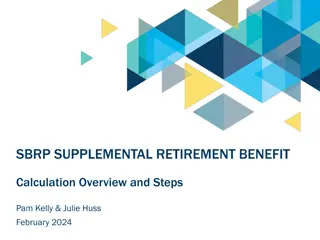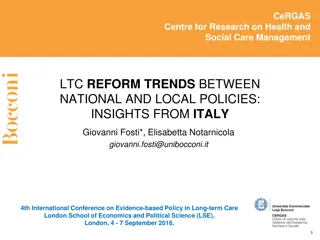Women's Retirement Challenges in Italy: Insights from NDC and Pension Reforms
Explore how Notional Defined Contribution (NDC) reforms in Italy impact women's retirement plans. Analyze the gender gap in expected retirement ages, the role of eligibility constraints, and the potential solutions to address lower retirement elasticity in women within the context of a dual labor market. Discover the implications of NDC on social security and pension sustainability in Italy.
Download Presentation

Please find below an Image/Link to download the presentation.
The content on the website is provided AS IS for your information and personal use only. It may not be sold, licensed, or shared on other websites without obtaining consent from the author. Download presentation by click this link. If you encounter any issues during the download, it is possible that the publisher has removed the file from their server.
E N D
Presentation Transcript
Les comptes notionnels, les femmes et l Italie Antoine Bozio, Institute for Fiscal Studies
NDC and the labour market in Italy Two papers from Tito Boeri Pension Reforms and Women Retirement Plans (joint with Agrar Brugiavinni) Is Social Security Secure with NDC? (joint with Vincenzo Galasso) Common theme NDC reform in 1995 in Italy Are pensions of women and unemployed at risk? Is labour market reform a necessary complement to the NDC pension reform? Main proposal A unique labour contract should address the problem of dual labour markets in Italy and elsewhere
Pension Reforms and Women Retirement Plans Background Women have more gap years than men NDC reform in 1995, from a retributive system towards a contributive system Empirical method Dependent variable = expected retirement age Explanatory variables = X, gap years, (Peak value) Results Gap years are significant for women (Peak value) is higher for men Higher retirement elasticity of men? Binding eligibility constraints explain why women are less reactive to changes in pension rules than women?
Comments Low retirement elasticity of women? Interesting result given the general result on higher labour supply elasticity of women during life Other similar results on French data (Bozio 2006, 2010) Why is this the case? Authors suggest eligibility constraints Is there evidence that it is really eligilibity constraint that explains lower retirement elasticity of women? Other possible explanations (joint decision in household, income effects etc.)?
Is Social Security Secure with NDC? The paper Italy suffers from a dual labour market, with increasing share of fixed term contract, with higher probability of unemployment spells NDC reforms has increased the link between contributions and pensions => Those who will suffer from these unemployment spells will also suffer very reduced pensions Main analysis NDC system is fine in itself Interaction of NDC and dual labour market poses problem Unique labour contract could resolve the dual labour market and thus solve the issues with pensions
Comments Italian NDC is one of a variety Italian reform has not implemented many safeguards for career breaks Very different from the Swedish brand of NDC Even without a dual labour market, this is a problem Does NDC really makes the dual labour market worse for a given level of redistribution? Pension rights are accrued since the start of the career Pension contributions are more valued by younger workers => increased labour supply Lower incentives to set seniority wages Dual labour market does not need NDC to be problematic

















































